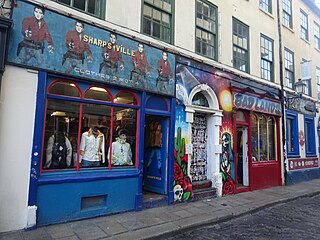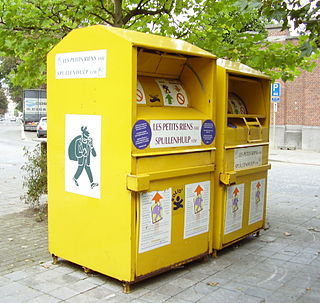
Consumerism is a social and economic order in which the goals of many individuals include the acquisition of goods and services beyond those that are necessary for survival or for traditional displays of status. Consumerism has historically existed in many societies, with modern consumerism originating in Western Europe before the Industrial Revolution and becoming widespread around 1900. In 1899, a book on consumerism published by Thorstein Veblen, called The Theory of the Leisure Class, examined the widespread values and economic institutions emerging along with the widespread "leisure time" at the beginning of the 20th century. In it, Veblen "views the activities and spending habits of this leisure class in terms of conspicuous and vicarious consumption and waste. Both relate to the display of status and not to functionality or usefulness."

In marketing, a product is an object, or system, or service made available for consumer use as of the consumer demand; it is anything that can be offered to a market to satisfy the desire or need of a customer. In retailing, products are often referred to as merchandise, and in manufacturing, products are bought as raw materials and then sold as finished goods. A service is also regarded as a type of product.
Ethical consumerism is a type of consumer activism based on the concept of dollar voting. People practice it by buying ethically made products that support small-scale manufacturers or local artisans and protect animals and the environment, while boycotting products that exploit children as workers, are tested on animals, or damage the environment.

Used goods, also known as secondhand goods, are any item of personal property offered for sale not as new, including metals in any form except coins that are legal tender, but excluding books, magazines, and postage stamps. Used goods may also be handed down, especially among family or close friends, as a hand-me-down.
Thrift store chic refers to a style of dressing where clothes are cheap and/or used. Clothes are often bought from thrift stores such as the Salvation Army, Goodwill, or Value Village. Originally popular among the hippies of the late 1960s, this fashion movement resurfaced during the mid-1980s among teenagers, and expanded into the 1990s with the growing popularity of such music and style influences including the grunge band Nirvana. Thrift store chic can be considered as an anti-fashion statement because it does not follow fashion trends and does not attempt to look expensive or new.

Vintage clothing is a generic term for garments originating from a previous era, as recent as the 1990s. The term can also be applied in reference to second-hand retail outlets, e.g. in vintage clothing store. While the concept originated during World War I as a response to textile shortages, vintage dressing encompasses choosing accessories, mixing vintage garments with new, as well as creating an ensemble of various styles and periods. Vintage clothes typically sell at low prices for high-end name brands.

Fast fashion is the business model of replicating recent catwalk trends and high-fashion designs, mass-producing them at a low cost, and bringing them to retail stores quickly while demand is at its highest. The term fast fashion is also used generically to describe the products of the fast fashion business model.

Textile recycling is the process of recovering fiber, yarn, or fabric and reprocessing the material into new, useful products. Textile waste is split into pre-consumer and post-consumer waste and is sorted into five different categories derived from a pyramid model. Textiles can be either reused or mechanically/chemically recycled.

Sustainable fashion is a term describing products, processes, activities, and people that aim to achieve a carbon-neutral fashion industry built on equality, social justice, animal welfare, and ecological integrity. Sustainable fashion concerns more than fashion textiles or products, rather addressing the entire process in which clothing is produced, consumed and disposed of. The movement looks to combat the large carbon footprint that the fast fashion industry has created by reducing the environmental impact such as air pollution, water pollution and climate change.
Collaborative consumption is the set of those resource circulation systems in which consumers both "obtain" and "provide", temporarily or permanently, valuable resources or services through direct interaction with other consumers or through a mediator. It is sometimes paired with the concept of the "sharing economy". Collaborative consumption is not new; it has always existed.

The SWAP Team is a Canadian non-profit organization that facilitates large-scale clothing swaps partnered with local charities that accept the leftover clothing at the end of the swap. The organization has established chapters across Canada, and in the United States, Australia, and Switzerland. Collectively, the chapters have donated more than 18,000 garments to its charity partner, the Salvation Army.

Cotton recycling is the process of converting cotton fabric into fibers that can be reused into other textile products.
An alternative purchase network (APN) is a contemporary commerce channel established as an alternative to perceived consumerism, and the cultural and economic hegemony of the global market. Alternative purchase networks aim to promote ethical shopping behaviour, which has an environmentally-friendly approach and considers local realities.
Green consumption is related to sustainable development or sustainable consumer behaviour. It is a form of consumption that safeguards the environment for the present and for future generations. It ascribes to consumers responsibility or co-responsibility for addressing environmental problems through the adoption of environmentally friendly behaviors, such as the use of organic products, clean and renewable energy, and the choice of goods produced by companies with zero, or almost zero, impact.

Fashion Revolution is a not-for-profit global movement represented by The Fashion Revolution Foundation and Fashion Revolution CIC with teams in over 100 countries around the world. Fashion Revolution campaigns for reform of the fashion industry with a focus on the need for greater transparency in the fashion supply chain. Starting in 2013, Fashion Revolution has designated the anniversary of the Rana Plaza disaster in Bangladesh as Fashion Revolution Day and holds events each year. Between 2014 and 2020, millions of people around the world called on brands to answer the question Who Made My Clothes? The hashtag #WhoMadeMyClothes became the no.1 global trend on Twitter. They have faced criticisms specifically about the Transparency Index.
Vinted is a Lithuanian online marketplace for buying, selling and exchanging new or secondhand items, mainly clothing and accessories.

Slow fashion is an aspect of sustainable fashion and a concept describing the opposite to fast fashion, part of the "slow movement" advocating for clothing and apparel manufacturing in respect to people, environment and animals. As such, contrary to the industrial practices of fast fashion conglomerates, slow fashion involves local artisans and the use of eco-friendly materials, with the goal of preserving crafts and the environment which, ultimately, provides value to all, slow fashion brands, consumers and retailers.

The fashion industry, particularly manufacture and use of apparel and footwear, is a significant driver of greenhouse gas emissions and plastic pollution. The rapid growth of fast fashion has led to around 80 billion items of clothing being consumed annually, with a large number going to landfill.

The COVID-19 pandemic affects the global fashion industry as governments close down manufacturing plants, and through store closures, and event cancellations to slow the spread of the virus. The coronavirus pandemic has had a major impact on fashion brands worldwide. At the same time, the fashion industry faces challenges in consumer demand. New opportunities are also presenting themselves as fashion brands shift to making fashionable coronavirus face masks. The ongoing COVID-19 pandemic is inevitably changing the fashion world forever. Domenico de Sole, chairman of Tom Ford International, remarked that "I have seen a lot of difficult situations in my long career and this has been the most devastating event, not just for fashion and luxury, but all industries."

Vintage clothing refers to clothing from a different era and can range from high-end designer items to everyday wear. Though debated, the age of a piece of clothing to be considered vintage is between 10 to 20 years. In recent years, the popularity of vintage clothing has grown, as consumers seek unique and sustainable fashion options.















